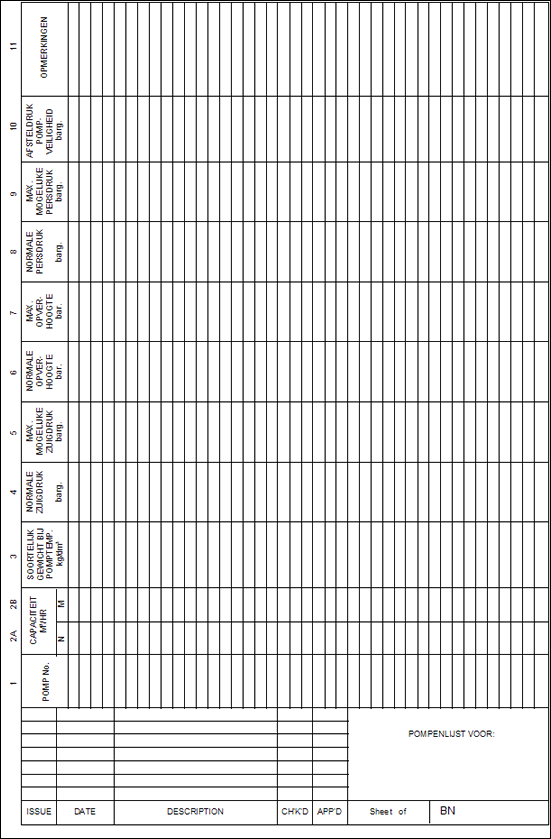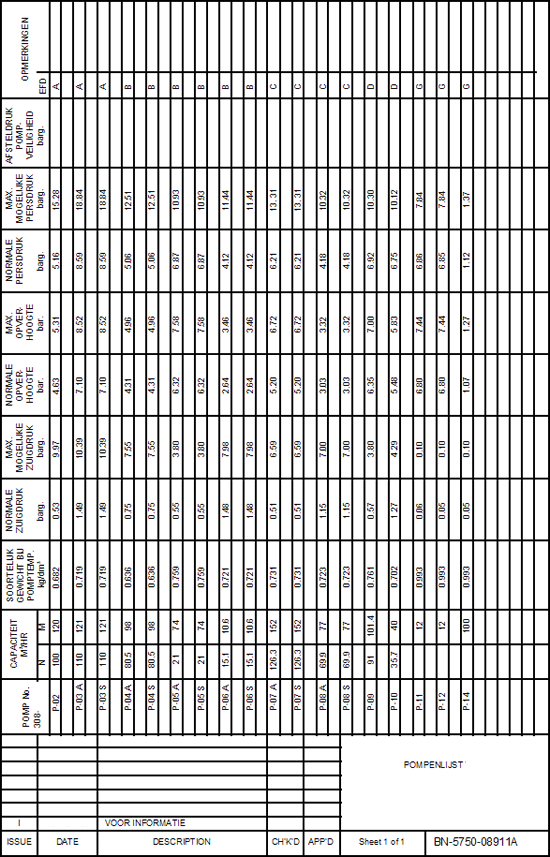Table of Contents
- Purpose
- General
- Responsibilities
- Guide Lines
- Flowchart (for the Netherlands only)
- References
- Attachments
1. Purpose
The purpose of this guide is to describe how the pump list, produced for submission to the Dutch Pressure Vessel Authority (currently named "Stoomwezen"), will be prepared and to provide information on its completion with relevant data.
2. General
The pump list is a document, which is based on the requirement set by the Dutch Pressure Vessel Authority to provide information on the type, the drive and the maximum differential pressure of pumps and compressors (ref. 6.1). It is a desirable document for grass roots process installations and a helpful document for existing installations.
The pump list has no formal status as a document and will, consequently, not be approved or stamped by the Dutch Pressure Vessel Authority. The submission of the information is a mandatory activity.
For non-Dutch projects, a pump list may be prepared if considered necessary or helpful for the assessment of design conditions (see also ref. 6.2 and 6.3); in such case, it is an internal Company document only and does not require submission to third parties.
3. Responsibilities
The Project Manager or his delegate has the overall responsibility for the preparation, checking and issue of the pump list.
The Project Engineering Group is responsible for the preparation of the pump list.
The Authority Engineering Group is responsible for the checking of the pump list and for providing advisory services during its preparation.
4. Guide Lines
4.1 Requirement for a Pump List
The Project Manager or his delegate should, in concert with the Authority Engineer, establish whether a pump list is necessary or desired for the project. He should also assign the individual engineer(s) responsible for the preparation of the pump list(s).
4.2 Form, Language and Document Numbering
4.2.1 Basic Form
The basic form is shown in Attachment 1 of this guide. The column numbers 1 through 11 in this Attachment have been added for easy reference and are not part of the form.
Blank pump list vellums are available with the Authority Engineering Group; see Attachment 2 for a copy. An 'electronic' version of the form can be developed per individual project if so desired.
4.2.2 Language
The language on the pump list should normally be Dutch for pump lists prepared for Dutch projects. The use of English is, however, generally accepted by the Dutch Pressure Vessel Authority.
4.2.3 Pump List Document Numbering
The pump list document lead number is defined in ref. 6.4 as '911' and should be used unless otherwise instructed by the Project Manager. A client document number should be added if required by the contract.
Note: For large projects, there may be more than one pump list; see Attachment 1.
4.3 Preparation
4.3.1 Supply of Data
The data for the columns 1 through 11 should be supplied by Process Engineering or taken from pump data requisition sheets and/or pump calculation sheets after these have been checked by Process Engineering.
The pump list can also be used for compressors and blowers.
4.3.2 Filling out the Pump List
The pump list should be filled out by the assigned project engineer(s) in cooperation with Process Engineering. Attachment 1 provides details for the various columns as necessary.
4.3.3 Completeness and Presentation of Data
The filled out pump list should be checked by the Authority Engineering Group for completeness and the way in which the data are presented. After this has been done, the list can be signed for 'checked'.
4.3.4 Approval and Issue
The pump list should be signed for approval and issue by the Project Manager or his delegate. After this step, the list is available for submission to the (Dutch) Pressure Vessel Authority. Client's comments are normally not collected, but the client is - also in the absence of contractual requirements regarding this point - entitled to receive a copy.
4.3.5 Actualization and Finalization of the Pump List
The pump list should be updated, at regular intervals, in accordance with information taken from (see also 4.4.2):
-
Measured performance curves of pumps and compressors, obtained from Procurement (Inspection or Vendor Document Handling Group).
-
Engineering flow scheme information on safety devices.
The Project Manager should decide whether "as built" finalization of the pump list is necessary.
4.3.6 Example of Completed Pump List
An example of a completed pump list is shown in Attachment 3.
4.4 Contacts with the Pressure Vessel Authority
4.4.1 Submission of the Pump List to the Pressure Vessel Authority
The pump list will be submitted to the Pressure Vessel Authority if desired or useful within the frame work of the assessment work done by that Authority. Such submission is, for Dutch projects, usually done by or via the Authority Engineering Group (see ref. 6.5).
4.4.2 Review by the Dutch Pressure Vessel Authority (Stoomwezen)
Stoomwezen will review during the assessment work the pump list and, during the preparation for the so-called "nader onderzoek" (see ref. 6.6), the test curve of each pump. Therefore, the pump list should reflect the actual situation and should be actualized from time to time (see ref. 4.3.5).
5. Flowchart (for the Netherlands only)

6. References
Document
Number Title Level
6.1 G-0401 Stoomwezen Rule "Behandelingsprocedures" -
6.2 BN-EG-UE1 Pressure Temperature Profile 5
6.3 BN-EG-UE2 General Rules to Establish Mechanical
Design Pressures and Temperatures 5
6.4 BN-W-UE301 Numbering of Project Documents 4
6.5 BN-EG-UE203 Submitting Information to Pressure Vessel
Authorities 5
6.6 BN-EG-UE206 "Nader Onderzoek" by Stoomwezen 5
7. Attachments
1. Notes regarding the preparation of the pump list (3 sheets).
2. Blank pump list form (1 sheet).
3. Example of completed pump list (1 sheet).
Notes Regarding the Preparation of the Pump List
1. Details For Filling Out The Various Columns
For the form and the numbering of the columns, see Attachment 2.
1.1 Columns 1, 3 and 11 (Pump Number, Density, Remarks)
The columns 1, 3 and 11 are self-explanatory. The molecular weight can be stated instead of the density for compressors and blowers.
1.2 Columns 2A and 2B (Capacity)
In the columns 2A and 2B the "normal" and "maximum" (rated) capacities as stated on the pump data requisition sheets should be indicated. The flows should be stated in kg/h for compressors and blowers.
1.3 Column 4 (Normal Suction Pressure)
Column 4 should state the suction pressure under normal operating conditions. Static head and tray pressure drop should be taken into account to avoid cumulative effects. For suction pressures below one (1) barg the use of the negative figure is preferred above the figure in bara.
Note: This is in accordance with Stoomwezen practices.
1.4 Column 5 (Maximum possible Suction Pressure)
Column 5 should indicate the suction pressure which occurs when the vessel from which is pumped is operating at the pressure for which it is protected or designed (i.e. opening pressure of relief valve or design pressure). Static head and tray pressure drop should be taken into account to avoid cumulative effects.
1.5 Column 6 (Normal Differential Pressure)
Column 6 should indicate the differential pressure at the (normal) operating point of the pump or compressor.
1.6 Column 7 (Maximum Differential Pressure)
Column 7 should indicate the maximum differential pressure. In the majority of cases, this will be at zero flow.
1.7 Columns 8 and 9 (Normal and Maximum Discharge Pressure)
Column 8 gives the sum of figures in columns 4 and 6, column 9 the sum of the figures in columns 5 and 7.
1.8 Column 10
Column 10 should indicate the setting of the discharge pressure safety device if installed. The setting shall normally be lower than the figure of column 9 and take static head effects into account.
Note: The preparation of the pump list may even lead to the conclusion, that such safety device is required.
The design pressure of the discharge piping - and sometimes equipment as well, depending upon how and where it is protected against overpressure - shall be equal to or higher than the figure of column 9, if no pressure safety device is or will be installed.
2. Shortcut Methods for First Issue
In some cases, the pump list will initially be prepared in an early stage of the project; pump and compressor curves, other that catalogue or proposal curves, are not available in that stage. For a reasonable estimate of the pressure levels, the following shortcuts can be used as a first approach:
2.1 For E-motor driven centrifugal pumps the maximum differential pressure should be taken as 120% of the normal differential pressure.
This figure should be checked against the actual figure once available (e.g. from the actually measured pump curve) and the necessary corrections should be made as necessary.
In some cases it is advisable to order pumps on basis of a specified maximum differential pressure; this does not replace the check against the measured pump curve!
Notes:
- Basically identical centrifugal pumps may still show different curves due to small differences between their impeller performance.
- Reciprocating pumps have almost always a pressure protection devise at their discharge side; the pump curve is, for these pumps, hardly a useful tool.
2.2 For turbine driven pumps the maximum differential pressure should be taken as 125% of the normal differential pressure; this figure should be checked against the actual figure once available (e.g. from the actually measured pump curve) and the necessary corrections should be made as necessary.
The design pressure of the equipment and piping in the discharge system should be carefully reviewed to establish the need for pressure protection devices.
3. Other Notes
3.1 Large projects usually involve more than one process unit; in these cases, it is advisable to prepare a pump list for each process unit. This will also simplify the communication with the Pressure Vessel Authority, if they require or use these pump lists.
3.2 Pumps with a dual service at different pressure levels should be treated with extra care. The discharge piping and equipment should be designed for the most severe possible combination of pressure and temperature up to and including the last block valve in the system. The pump list should, in such case, give the data for both services.
Note: Exceptions can sometimes be allowed for specific cases such as start-up lines and other infrequently occurring but carefully supervised operating situations. The decision to take such exception may be questioned by the Pressure Vessel Authority and should be well defendable.
3.3 Some chemical plants in particular can be sufficiently complicated to warrant a full investigation and qualification of all possible pumping circuits. Care should also be taken in situations, where two pumps may operate in parallel.



